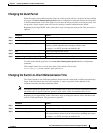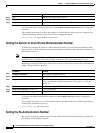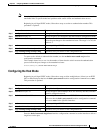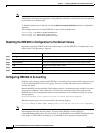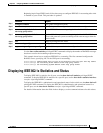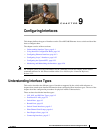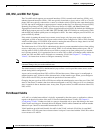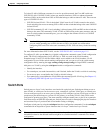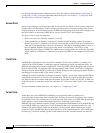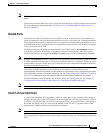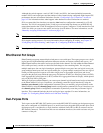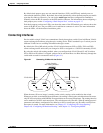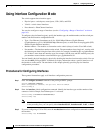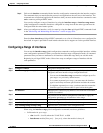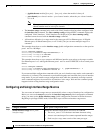
9-3
Cisco ME 3400 Ethernet Access Switch Software Configuration Guide
OL-9639-06
Chapter 9 Configuring Interfaces
Understanding Interface Types
To isolate VLANs of different customers in a service-provider network, the Cisco ME switch uses
UNI-ENI VLANs. UNI-ENI VLANs isolate user network interfaces (UNIs) or enhanced network
interfaces (ENIs) on the switch from UNIs or ENIs that belong to other customer VLANs. There are two
types of UNI-ENI VLANs:
• UNI-ENI isolated VLAN—This is the default VLAN state for all VLANs created on the switch.
Local switching does not occur among UNIs or ENIs on the switch that belong to the same UNI-ENI
isolated VLAN.
• UNI-ENI community VLAN—Local switching is allowed among UNIs and ENIs on the switch that
belong to the same UNI community VLAN. If UNIs or ENIs belong to the same customer, and you
want to switch packets between the ports, you can configure the common VLAN as a UNI-ENI
community VLAN.
Note Local switching takes place between ENIs and UNIs in the same community VLAN. Because
you can enable spanning tree on ENIs, but not on UNIs, you should use caution when
configuring ENIs and UNIs in the same community VLAN. UNIs are always in the forwarding
state.
For more information about UNI VLANs, see the “UNI-ENI VLANs” section on page 11-5.
To configure VLANs, use the vlan vlan-id global configuration command to enter VLAN configuration
mode. The VLAN configurations for VLAN IDs 1 to 1005 are saved in the VLAN database.
Extended-range VLANs (VLAN IDs 1006 to 4094) are not added to the VLAN database. VLAN
configuration is saved in the switch running configuration, and you can save it in the switch startup
configuration file by entering the copy running-config startup-config privileged EXEC command.
Add ports to a VLAN by using the switchport interface configuration commands:
• Identify the interface.
• For a trunk port, set trunk characteristics, and if desired, define the VLANs to which it can belong.
• For an access port, set and define the VLAN to which it belongs.
• For a tunnel port, set and define the VLAN ID for the customer-specific VLAN tag. See Chapter 13,
“Configuring IEEE 802.1Q and Layer 2 Protocol Tunneling.”
Switch Ports
Switch ports are Layer 2 only interfaces associated with a physical port. Switch ports belong to one or
more VLANs. A switch port can be an access port, a trunk port, a private-VLAN port, or a tunnel port.
You can configure a port as an access port or trunk port. You configure a private VLAN port as a host or
promiscuous port that belongs to a private-VLAN primary or secondary VLAN. (Only NNIs can be
configured as promiscuous ports.) You must manually configure tunnel ports as part of an asymmetric
link connected to an IEEE 802.1Q trunk port. Switch ports are used for managing the physical interface
and associated Layer 2 protocols and do not handle routing or bridging.
Configure switch ports by using the switchport interface configuration commands. Use the switchport
command with no keywords to put an interface that is in Layer 3 mode into Layer 2 mode.
Note When you put an interface that is in Layer 3 mode into Layer 2 mode, the previous configuration
information related to the affected interface might be lost, and the interface is returned to its default
configuration.



